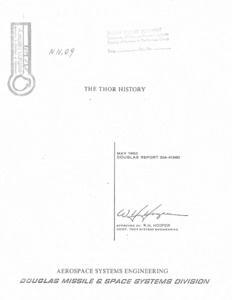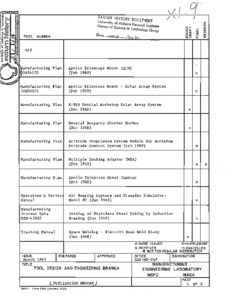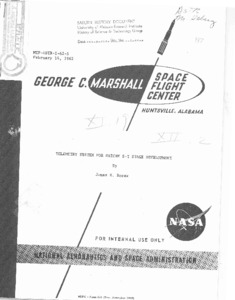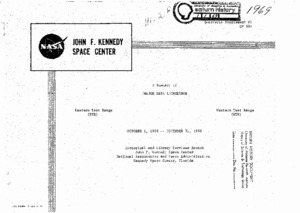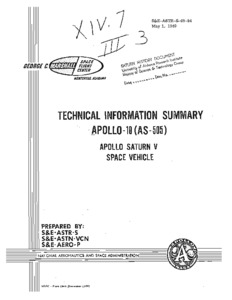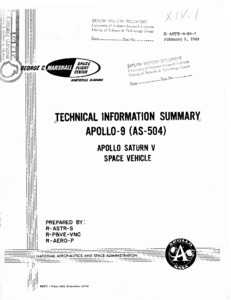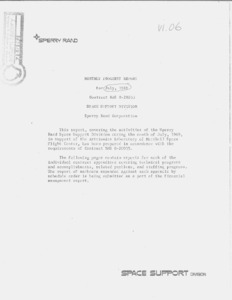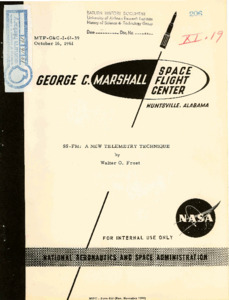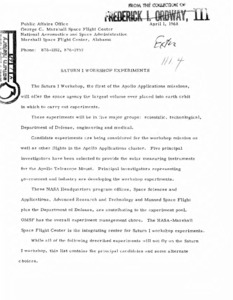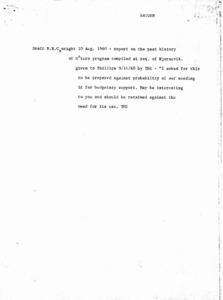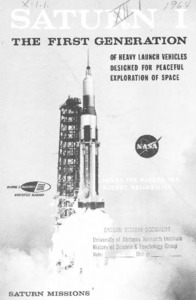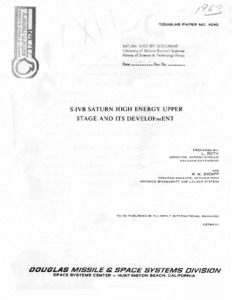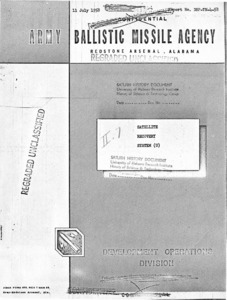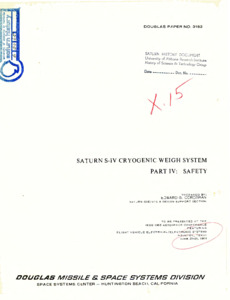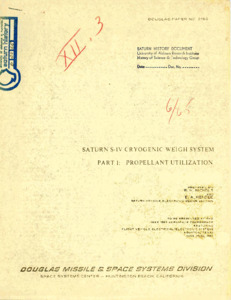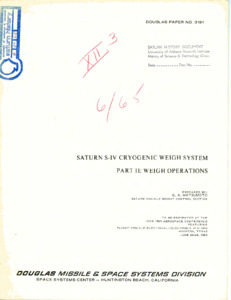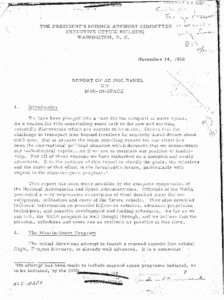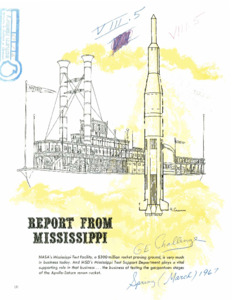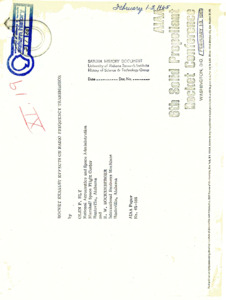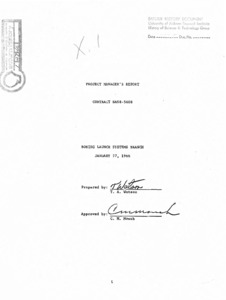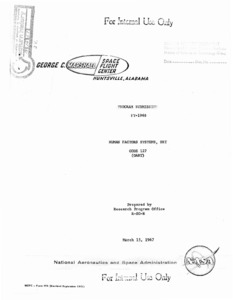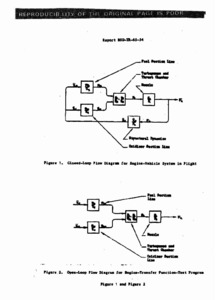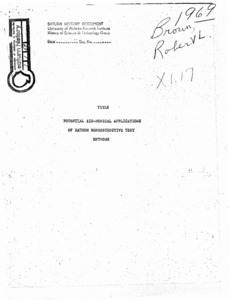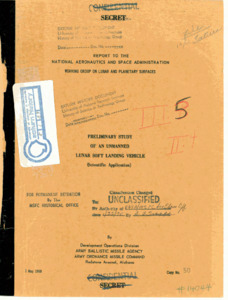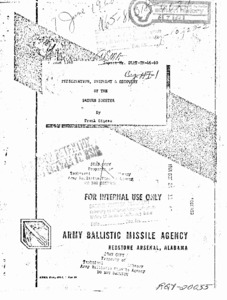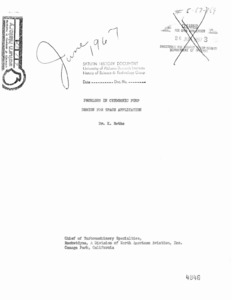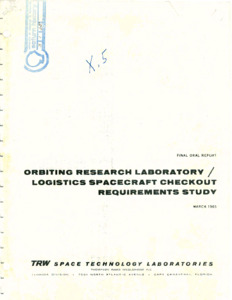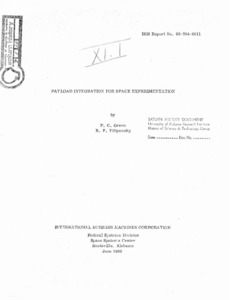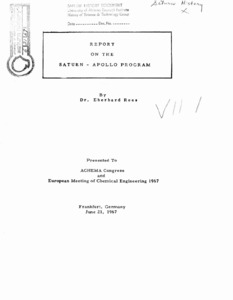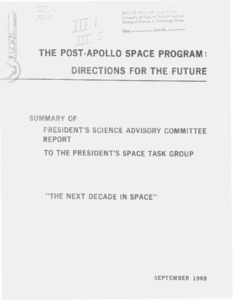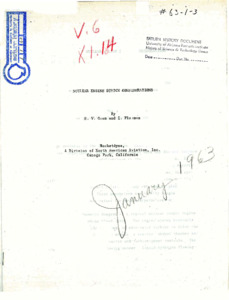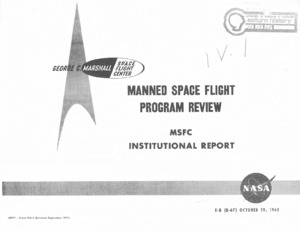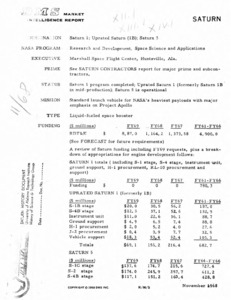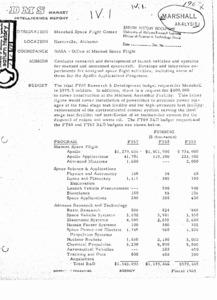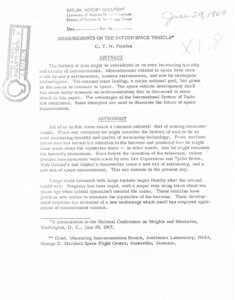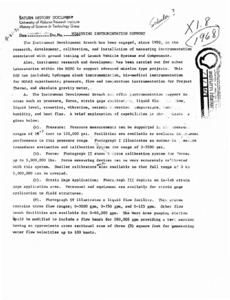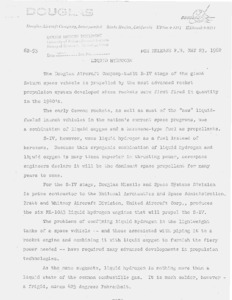
Browse Items (192 total)
Sort by:
-
The History of Thor.
This history is intended as a quick orientation source and as a ready-reference for review of the Thor and its systems. The report briefly states the development of Thor, summarizes and chronicles Thor missile and booster launchings, provides illustrations and descriptions of the vehicle systems, relates their genealogy, explains some of the performance capabilities of the Thor and Thor-based vehicles used, and focuses attention to the exploration of space by Douglas Aircraft Company, Inc. -
"Tool and Engineering Branch publication report."
Report list detailing the state of manufacturing plans as either "Rough" or "Final" drafts. -
"The TV system for the Apollo telescope mount."
Focuses on the construction and future use of the Apollo space telescope. The components described in this paper except for those listed otherwise were designed by the Space Support Division of Sperry Rand Corporation to specifications established by NASA's Marshall Space Flight Center in Huntsville, Alabama. Appreciation is extended to MSFC for permission to publish this paper and for data and help provided for its preparation. -
"Telemetry system for Saturn S-I stage development."
The telemetry system used on the Saturn S-I stage for the transmission of vehicle test data is described. Multiplex and modulationtechniques such as PAM/FM/FM, SS/FM and PGM are used in the system. The diverse data requirements for developing the eight-engineliquid-fueled stage necessitated the use of a combination of severalmodulation techniques to efficiently handle the data. A cursory comparisonis made of the merits of each technique. Physical and electricalrequirements and characteristics of the system are outlined. -
"Statistical model for Saturn electrical support equipment mission availability."
This report presents the logic leading to a mathematical expression for mission availability. Mission availability is treated as the probability that the cumulative downtime occurring during a mission of given length will be less than the time constraint. This is opposed to more general approaches such as steady state or instantaneous availability or operating time versus real time. We intend to present a practical and usable mathematical model by deduction and demonstration. The development is based on exponentially distributed downtimes. Experience shows that certain systems follow exponential downtime distributions except near zero. This error is often so small that it may be neglected. A future report will present a downtime distribution which will account for this small error. -
"A summary of major NASA launchings" between October 1st and December 31st, 1968.
This is the first Quarterly Supplement to the October 1968 edition of GP 381, ''A Summary of Major NASA Launchings (Eastern Test Range and Western Test Range)." This Supplement covers the period from October 1 to December 31, 1968. Two additional Quarterly Supplements will be issued during 1969. Each of these will list those major NASA launchings occurring during the three-month period it covers. The basic publication will be revised and reissued, incorporating the information contained in the Supplements, as well as covering the final three-month period, subsequent to October 1, 1969. William A. Lockyer, Jr. -
"Technical information summary Apollo-10 (AS-505) Apollo Saturn V space vehicle."
The document presents a brief and concise description of the AS-505 Apollo Saturn Space Vehicle. Where necessary, for clarification, additional related information has been included. -
"Technical Information Summary Apollo-9 (AS-504) Apollo Saturn V Space Vehicle."
The document presents a brief and concise description of the Apollo 9 Saturn Space Vehicle. -
"Sperry Rand monthly progress report for July, 1969."
The following pages contain reports for each of the individual contract appendices covering technical progress and accomplishments, related problems, and staffing progress. The report of manhours expended against each appendix by schedule order is being submitted as a part of the financial management report. -
"A new telemetry technique."
A technique new to telemetry is discussed which promises to alleviate an enigma facing the telemetry engineer : How to adequately transmit the avalanche of vibration and other wideband data desired in the development phase of large missiles and launch vehicles. The data channels are stacked in the frequency spectrum as single sideband subcarriers which frequency modulate the RF carrier. The system design utilizes to advantage the statistical properties of vibration data to achieve maximum data transmission efficiency from the available RF carrier deviation. However, in contrast to proposed statistical predigestion techniques, the data is transmitted in raw form. -
"Saturn I workshop experiments."
April 1, 1968.; Stamped on first page is From the Archives of Frederick I. Ordway, III. -
"Saturn: draft."
Report on the history of the Saturn program. -
"Saturn I : the first generation of heavy launch vehicles designed for peaceful exploration of space."
A basic description of the Saturn rockets alongside diagrams for context. -
"S-IVB Saturn high energy upper stage and its development."
The development of carrier rockets For manned space missions has been one of the major activities in the aerospace field during the past decade. The early space efforts were made possible by the existence of large ballistics missiles. It soon became obvious that the delivery of weapons and the launch of large spacecraft could not be combined into one operational system in an efficient way; therefore, a family of spacecraft boosters had to be created. -
"Satellite recovery system."
Report focusing on the problems of the satalite recovery system and the possible solutions for those problems. -
"Saturn S-IV cryogenic weigh system. Part IV : safety."
During cryogenic weigh system operation, hydrogen when combined with oxygen can create an unsafe condition. Therefore the concentration of the residual oxygen and hydrogen from leaks in the cryogenic weigh environmental bags must be known at all times during the cryogenic weigh. Hydrogen and oxygen detectors will provide the optimum method for maintaining safe conditions. Hydrogen properties and safe mixtures are reviewed. The method selected to analyze the oxygen content is discussed. The selection, development, and testing of a hydrogen detector system is examined. -
"Saturn S-IV cryogenic weigh system. Part I : propellant utilization."
In order to achieve maximum vehicle efficiency, it is essential that the vehicle propellants be loaded to desired values and that these propellants approach simultaneous depletion at the end of powered flight. To accomplish precise loading and assure minimum residuals, a highly accurate and repeatable, vehicle located, propellant management (PM) or propellant utilization (PU) system must be used. As the ability to load propellants to predetermined values depends directly on the ability of the system to accurately sense the propellant masses, it is essential that the system be calibrated with respect to propellant mass under conditions resembling those to be experienced during final loading and powered flight. The use of a cryogenic weight system will reduce the unknown factors in capacitance sensor element shaping, tank geometry, and propellant properties to a degree which will permit the determination of propellant masses to with .025%. -
"Saturn S-IV cryogenic weigh system. Part II : weigh operations."
Two basic methods for mass determination are: (1) direct measurement, (2) volume and density determination. Both methods or variations have been used to determine space vehicle propellant mass with varying degrees of success. Stringent propellant loading accuracy requirements of k0.5 percent for the Saturn S-IV Stage have led to the development of a Cryogenic Calibration Weigh System. The method employs accurate electronic force transducers and measuring systems as the standard and experimental weighings have verified achievement of better than the required accuracy. -
"Report of Ad Hoc panel on Man-in-Space."
It is the purpose of this report to clarify the goals, the missions and the costs of this effort in the forseeable future, particularly with regard to the man-in-space program -
"Report From Mississippi."
Report detailing the progress NASA's Mississippi test facility has made testing the Apollo-Saturn rocket. -
"Rocket exhaust effects on radio frequency transmission."
Presented by Olen P. Ely, National Aeronautics and Space Administration, Marshall Space Flight Center, Huntsville, Alabama and R. W. Hockenberger, International Business Machines. Paper that explores the effects of rocket-engine exhaust on radio-signals. -
"Project Manager's Report."
Report detailing the costs of materials and contracts. -
"Human factor systems."
Reports and resumes detailing funds, guidelines and assets. -
"Pogo analysis of the Saturn Propulsion System."
Report that contians images of graphs, photographs and diagrams. -
"The potential bio-medical applications of Saturn nondestructive test methods."
A brief history and purpose of nondestructive methods followed by a discussion of those methods. -
"Preliminary study of an unmanned lunar soft landing vehicle (Scientific Application)."
Report to the National Aeronautics and Space Administration Working Group on Lunar and Planetary Surfaces. -
Preservation, shipment & recovery of the Saturn booster.
The purpose of this report is to present the shipping and recovery procedures for the Saturn booster. -
"Problems in cryogenic pump design for space application."
Report detailing the problems surrounding cryogenic pump design for space travel and missions. -
"Orbiting research laboratory/logistics spacecraft checkout requirements study."
This report presents the results of the study of Orbiting Research Laboratory and Logistic Spacecraft Checkout Requirements as they relate to prelaunch operations at MILA. The study was performed jointly by the Florida Division and the Systems Research and Analysis Division of TRW Space Technology Laboratories for NASA under the terms of contract NAS10-1076. -
"Payload integration for space experimentation."
Space experimentation requires an increasingly complex planning and systems engineering effort to meet the demand for highest precision and reliability of all measurements and observations. A companion paper discusses the interfaces between the scientific/technical areas of space experimentation and the instruments, subsystems and support systems within the spacecraft. This paper deals with the organization and the procedures which are needed to perform the difficult payload integration process for space experimentation. In the course of this process it is necessary to define the experiments completely, to describe all instruments in terms of engineering specifications, to investigate the commonality of equipment, to group the experiments into mission compatible payloads, to specify acceptable loads on all subsystems and astronauts (when present) and to plan for all contingencies during the flight. -
"Report on the Saturn-Apollo program."
Presented to ACHEMA Congress and European Meeting of Chemical Engineering 1967, Frankfurt, Germany, June 21, 1967 by Dr. Eberhard Rees.; Includes slide numbers. -
"Post-Apollo space program report: directions for the future."
Summary of President's Advisory Committee report to the President's Space Task Group. -
"Nondestructive testing of space vehicle liquid propellant rocket engines."
Presented at the Western Metals Congress, Los Angeles, California, 15 March 1967.; Archive copy is a photocopy.; ABSTRACT: This report describes the various nondestructive test methods employed to evaluate materials and processes used in the manufacture of large liquid propellant rocket engines at the Rocketdyne Division of North American Aviation, Inc. The contents of the paper were purposely oriented for an audience of aerospace, design and materials engineers. A brief description of liquid propellant rocket engine reliability is presented. The relationship of standards and specifications to nondestructive testing is discussed and various test methods are described along with a discussion of their applications and limitations. The sequence of events leading up to the use of nondestructive testing in production inspection is presented. Finally, the organization of labor directly related to nondestructive testing is given. -
"Nuclear engine design considerations."
The intent of this paper is to examine the static test countdown organization and discuss the need for a systematic method to organize a countdown. -
"Manned space flight program review : MSFC institutional report."
Report covers R & D, Administrative operations, staffing, facilities, and funding. -
"Saturn : DMS market intelligence report."
Lists numerous costs. -
"Marshall analysis : DMS Market Intelligence Report."
Lists numerous costs. -
"Measurements on the Saturn space vehicle."
The history of man might be considered as an ever increasing quantity and quality of measurements. Measurements related to space have been made by early astronomers, modern astronomers, and now by aerospace technologists. The manned lunar landing, a major national goal, has given us the means to measure in space. The space vehicle development itself has made heavy demands on instrumentation; this is discussed in some detail in this paper. The advantages of the International System of Units are mentioned. Some examples are used to illustrate the future of space measurement. -
"Measuring instrumentation support."
Article refers to photographs, providing context to what is shown in them with formulas and measurements. -
"Liquid Hydrogen."
Review detailing the use of liquid hydrogen in Saturn rockets.
